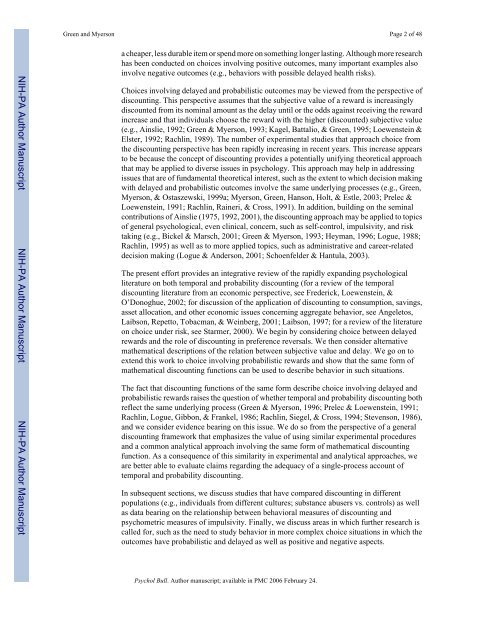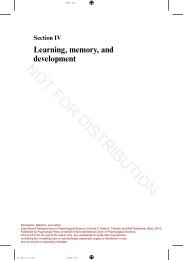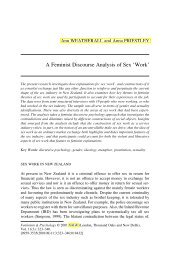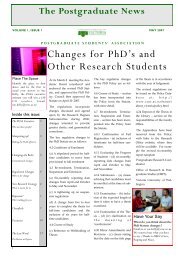green & myerson 2004.. - of /courses
green & myerson 2004.. - of /courses
green & myerson 2004.. - of /courses
You also want an ePaper? Increase the reach of your titles
YUMPU automatically turns print PDFs into web optimized ePapers that Google loves.
Green and Myerson Page 2 <strong>of</strong> 48<br />
NIH-PA Author Manuscript NIH-PA Author Manuscript NIH-PA Author Manuscript<br />
a cheaper, less durable item or spend more on something longer lasting. Although more research<br />
has been conducted on choices involving positive outcomes, many important examples also<br />
involve negative outcomes (e.g., behaviors with possible delayed health risks).<br />
Choices involving delayed and probabilistic outcomes may be viewed from the perspective <strong>of</strong><br />
discounting. This perspective assumes that the subjective value <strong>of</strong> a reward is increasingly<br />
discounted from its nominal amount as the delay until or the odds against receiving the reward<br />
increase and that individuals choose the reward with the higher (discounted) subjective value<br />
(e.g., Ainslie, 1992; Green & Myerson, 1993; Kagel, Battalio, & Green, 1995; Loewenstein &<br />
Elster, 1992; Rachlin, 1989). The number <strong>of</strong> experimental studies that approach choice from<br />
the discounting perspective has been rapidly increasing in recent years. This increase appears<br />
to be because the concept <strong>of</strong> discounting provides a potentially unifying theoretical approach<br />
that may be applied to diverse issues in psychology. This approach may help in addressing<br />
issues that are <strong>of</strong> fundamental theoretical interest, such as the extent to which decision making<br />
with delayed and probabilistic outcomes involve the same underlying processes (e.g., Green,<br />
Myerson, & Ostaszewski, 1999a; Myerson, Green, Hanson, Holt, & Estle, 2003; Prelec &<br />
Loewenstein, 1991; Rachlin, Raineri, & Cross, 1991). In addition, building on the seminal<br />
contributions <strong>of</strong> Ainslie (1975, 1992, 2001), the discounting approach may be applied to topics<br />
<strong>of</strong> general psychological, even clinical, concern, such as self-control, impulsivity, and risk<br />
taking (e.g., Bickel & Marsch, 2001; Green & Myerson, 1993; Heyman, 1996; Logue, 1988;<br />
Rachlin, 1995) as well as to more applied topics, such as administrative and career-related<br />
decision making (Logue & Anderson, 2001; Schoenfelder & Hantula, 2003).<br />
The present effort provides an integrative review <strong>of</strong> the rapidly expanding psychological<br />
literature on both temporal and probability discounting (for a review <strong>of</strong> the temporal<br />
discounting literature from an economic perspective, see Frederick, Loewenstein, &<br />
O’Donoghue, 2002; for discussion <strong>of</strong> the application <strong>of</strong> discounting to consumption, savings,<br />
asset allocation, and other economic issues concerning aggregate behavior, see Angeletos,<br />
Laibson, Repetto, Tobacman, & Weinberg, 2001; Laibson, 1997; for a review <strong>of</strong> the literature<br />
on choice under risk, see Starmer, 2000). We begin by considering choice between delayed<br />
rewards and the role <strong>of</strong> discounting in preference reversals. We then consider alternative<br />
mathematical descriptions <strong>of</strong> the relation between subjective value and delay. We go on to<br />
extend this work to choice involving probabilistic rewards and show that the same form <strong>of</strong><br />
mathematical discounting functions can be used to describe behavior in such situations.<br />
The fact that discounting functions <strong>of</strong> the same form describe choice involving delayed and<br />
probabilistic rewards raises the question <strong>of</strong> whether temporal and probability discounting both<br />
reflect the same underlying process (Green & Myerson, 1996; Prelec & Loewenstein, 1991;<br />
Rachlin, Logue, Gibbon, & Frankel, 1986; Rachlin, Siegel, & Cross, 1994; Stevenson, 1986),<br />
and we consider evidence bearing on this issue. We do so from the perspective <strong>of</strong> a general<br />
discounting framework that emphasizes the value <strong>of</strong> using similar experimental procedures<br />
and a common analytical approach involving the same form <strong>of</strong> mathematical discounting<br />
function. As a consequence <strong>of</strong> this similarity in experimental and analytical approaches, we<br />
are better able to evaluate claims regarding the adequacy <strong>of</strong> a single-process account <strong>of</strong><br />
temporal and probability discounting.<br />
In subsequent sections, we discuss studies that have compared discounting in different<br />
populations (e.g., individuals from different cultures; substance abusers vs. controls) as well<br />
as data bearing on the relationship between behavioral measures <strong>of</strong> discounting and<br />
psychometric measures <strong>of</strong> impulsivity. Finally, we discuss areas in which further research is<br />
called for, such as the need to study behavior in more complex choice situations in which the<br />
outcomes have probabilistic and delayed as well as positive and negative aspects.<br />
Psychol Bull. Author manuscript; available in PMC 2006 February 24.






